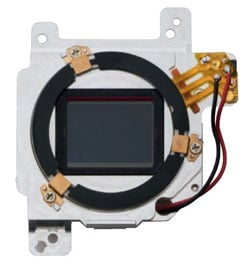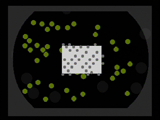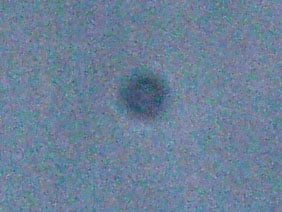Olympus E-510
-
-
Written by Gordon Laing
Olympus E-510 anti dust
More Features : Lenses and viewfinder / Screen and menus / Sensor and processing / Anti dust / Anti shake
Olympus E-510 features continued…
Lenses and viewfinder / Screen and menus / Sensor and processing / Anti dust / Anti shake
The Olympus E-510, like all Four Thirds models so far, employs a SuperSonic Wave Filter to combat the problem of dust entering the body and casting annoying shadows onto the sensor. The SSWF is widely regarded as one of the best in the industry, and in our tests on previous Olympus models it has certainly proven far more effective than rival systems.
The SSWF vibrates a special filter in front of the sensor in an attempt to shake-free any foreign particles which have entered the body. Unlike rival anti-dust systems though, the Four Thirds standard allows the vibrating filter to be positioned much further from the sensor itself. This helps a great deal, as any dust particles which remain are normally so far from the focal plane, they’re essentially rendered invisible at all but the smallest apertures.
 |
Olympus explained to Cameralabs the SSWF in the E-510 is the same as the E-410, but we’ve repeated our tests for the new body none-the-less. At this point it’s important to note the evaluation of anti-dust dust systems can never be as controlled or consistent as other tests. After all, there’s no way of counting the number or type of dust particles which currently lie within a body, nor any way to introduce a consistent number of test particles for it to subsequently get rid of. As such it’s impossible to conclude one system is categorically better than another at eliminating dust.
Just because something can’t be scientifically measured though, doesn’t mean it should be glossed-over or ignored in a review. Dust is a major complaint for most DSLR owners and anti-dust systems have become some of the most talked-about features in new bodies. As such even anecdotal evidence is valuable and by gathering it from a number of sources over time we can build up a picture of how effective, or ineffective a system performs. That’s our belief at Camera Labs, so for the record here’s what we found.
Like the E-400 and E-410, the new E-510 performs its SSWF anti-dust process every time the camera’s switched on and there’s no way to override it – but like these bodies, at least the earlier graphical animation advertising the SSWF has been dispensed with unless you power-up without a memory card inserted. So under normal conditions, the only indication the cleaning process is taking place is a small blue light by the shutter release flickering for just under a second during power-up.
 |
 |
Now to our anecdotal evidence. As with earlier Olympus bodies, there were no obvious dust marks on our E-510 test shots, so to place the SSWF under greater strain we deliberately took much less care when changing lenses.
We removed the lens from the E-510 and left the body open and face-up indoors for five minutes. We then repeated this outdoors, again for five minutes. While there’s no way of knowing exactly how much dust got into the body, we’re pretty confident such activity would have resulted in many visible dust marks on other DSLRs.
The easiest way to spot dust marks is to manually focus the lens to infinity and shoot a plain white surface from about 30cm away. It’s revealing to try this at different apertures, as the bigger the f-number, the sharper and more defined any dust marks will become. So the ultimate torture test would be at, say, f22, although to be fair it’s important to also test at the more common apertures used day-to-day.
We photographed the white surface as described with each aperture setting, then opened the images in Photoshop and zoomed-in to 100% for close examination using a calibrated Eizo CG210 monitor. With the kit lens zoomed-into 42mm and the aperture set to f5.6, f8 and f11, there was no evidence of dust. Closing the aperture further to f16 revealed a single very faint patch on the left side of the frame, which as expected became clearer at f22. Noting the exact position of the dust mark on the f22 image we went back over the other samples and while we now noticed an incredibly faint patch in the same spot on the f11 sample, it essentially remained invisible at wider apertures.
Below left you can see a 100% crop from the f22 sample showing the dust mark in the middle; remember this is a worst-case scenario, yet it impressively remains quite faint. Dust marks on other DSLRs at f22 are generally much darker and better defined. To make it more obvious though, we’ve severely compressed the Levels in Photoshop to produce the result below right.

|
Olympus E-510 dust example at f22 | ||
 | ||
| 100% crop measuring 282×212 pixels | 100% crop measuring 282×212 pixels with Levels | |
Apertures of f22 are not that common in day-to-day use, so we’ve taken a crop of the exact same area from the f8 sample and presented it at 100% below left. Let us assure you this is exactly the same area captured in the samples above, and as you can see – or rather not see – the dust mark has been rendered essentially invisible. Once again we’ve severely compressed the Levels in Photoshop for the image below right, but even there, the dust mark is not to be seen.
Olympus E-510 dust example at f8 | ||
 |  | |
| 100% crop measuring 282×212 pixels | 100% crop measuring 282×212 pixels with Levels | |
These tests may confirm that dust can settle on the E-510’s filter even after it has vibrated several times, but equally prove they’d essentially remain invisible on your photos unless shooting at the smallest apertures.
Once again it’s a great result for the SuperSonic Wave Filter – although its resistance to dust is as much to do with the distance between the filter and sensor as it is with the actual vibrating process itself. Either way, while the E-510 isn’t totally immune to dust, it still does a better job than its rivals at getting rid of it, or at least making it very hard to spot.




